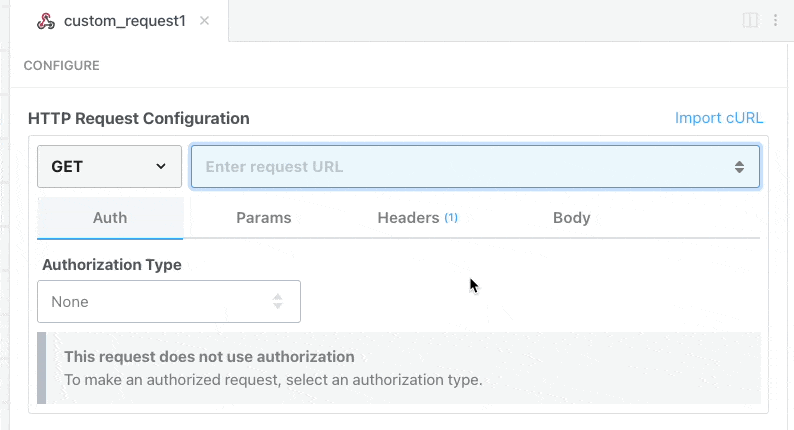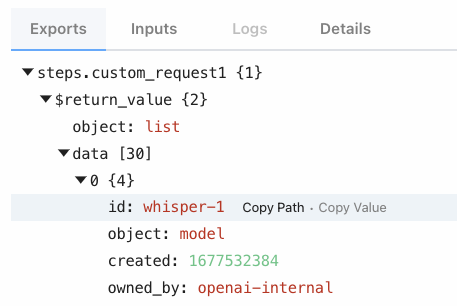import {
INVOICE_NOTIFICATION_OPTIONS,
LOCALE_OPTIONS,
PAYMENT_METHODS_OPTIONS,
} from "../../common/constants.mjs";
import { parseObject } from "../../common/utils.mjs";
import xendit from "../../xendit.app.mjs";
export default {
key: "xendit-create-invoice",
name: "Create Invoice",
version: "0.0.2",
annotations: {
destructiveHint: false,
openWorldHint: true,
readOnlyHint: false,
},
description: "Create a new invoice on Xendit platform [See the documentation](https://developers.xendit.co/api-reference/#create-invoice)",
type: "action",
props: {
xendit,
externalId: {
type: "string",
label: "External ID",
description: "ID of your choice (typically the unique identifier of an invoice in your system).",
},
amount: {
type: "string",
label: "Amount",
description: "Amount on the invoice. Min and max amounts are stated [here](https://docs.xendit.co/xeninvoice/payment-channels). The amount should be inclusive of any fees and or items that you may choose to include. If there is a difference between this amount and the sum of the price in the `items` parameters and or `fees` parameter, Xendit will refer to this amount parameter to create invoice. Do take note: if the currency or default currency is IDR and the amount includes decimals (e.g IDR 4550.50), the amount will be truncated to IDR 4550.",
},
description: {
type: "string",
label: "Description",
description: "Description of invoice - you can use this field to list what items are being paid for, or anything else of your choice that describes the function of the invoice.",
optional: true,
},
givenNames: {
type: "string",
label: "Given Names",
description: "Given name of the customer",
optional: true,
},
surname: {
type: "string",
label: "Surname",
description: "Surname of the customer",
optional: true,
},
email: {
type: "string",
label: "Email",
description: "Email address of the customer",
optional: true,
},
mobileNumber: {
type: "string",
label: "Mobile Number",
description: "Mobile phone number of the customer in E164 format",
optional: true,
},
addressCity: {
type: "string",
label: "City",
description: "The city of the customer",
optional: true,
},
addressCountry: {
type: "string",
label: "Country",
description: "The country of the customer",
optional: true,
},
addressPostalCode: {
type: "string",
label: "Postal Code",
description: "The postal code of the customer",
optional: true,
},
addressstate: {
type: "string",
label: "State",
description: "The state of the customer",
optional: true,
},
addressLine1: {
type: "string",
label: "Address Line 1",
description: "The address line 1 of the customer",
optional: true,
},
addressLine2: {
type: "string",
label: "Address Line 2",
description: "The address line 2 of the customer",
optional: true,
},
invoiceCreatedNotification: {
type: "string[]",
label: "Invoice Created Notification",
description: "Specify which channel you want to notify your end customer through when you create a payment/invoice. If you do not specify values for this object, your end user will not be notified for this notification type.",
options: INVOICE_NOTIFICATION_OPTIONS,
optional: true,
},
invoiceReminderNotification: {
type: "string[]",
label: "Invoice Reminder Notification",
description: "Specify which channel you want to notify your end customer through when you want to remind your customer to complete their payment. If you do not specify values for this object, your end user will not be notified for this notification type.",
options: INVOICE_NOTIFICATION_OPTIONS,
optional: true,
},
invoicePaidNotification: {
type: "string[]",
label: "Invoice Paid Notification",
description: "Specify which channel you want to notify your end customer through when they have successfully completed payment. If you do not specify values for this object, your end user will not be notified for this notification type.",
options: INVOICE_NOTIFICATION_OPTIONS,
optional: true,
},
invoiceDuration: {
type: "integer",
label: "Invoice Duration",
description: "Duration of time that the end customer is given to pay the invoice before expiration (in seconds, since creation). Default is 24 hours (86,400 seconds).",
optional: true,
},
successRedirectUrl: {
type: "string",
label: "Success Redirect URL",
description: "URL to redirect the customer to after successful payment.",
optional: true,
},
failureRedirectUrl: {
type: "string",
label: "Failure Redirect URL",
description: "URL to redirect the customer to after failed payment.",
optional: true,
},
paymentMethods: {
type: "string[]",
label: "Payment Methods",
description: "Specify the payment channels that you wish to be available on your Invoice.",
options: PAYMENT_METHODS_OPTIONS,
optional: true,
},
currency: {
type: "string",
label: "Currency",
description: "Currency of the amount that you created.",
optional: true,
},
locale: {
type: "string",
label: "Locale",
description: "The default language to display",
options: LOCALE_OPTIONS,
optional: true,
},
items: {
type: "string[]",
label: "Items",
description: "Array of items JSON objects describing the item(s) purchased. Max array size: 75. Mandatory for PayLater payment method. [See the documentation](https://developers.xendit.co/api-reference/#create-invoice) for further details.",
optional: true,
},
fees: {
type: "string[]",
label: "Fees",
description: "Array of items JSON objects describing the fee(s) that you charge to your end customer. This can be an admin fee, logistics fee, etc. This amount will be included in the total invoice amount and will be transferred to your balance when the transaction settles. Max array size: 10. [See the documentation](https://developers.xendit.co/api-reference/#create-invoice) for further details.",
optional: true,
},
metadata: {
type: "object",
label: "Metadata",
description: "An object containing any additional information you want to include with the invoice. This will be returned in the response and can be used for tracking or reporting purposes.",
optional: true,
},
},
async run({ $ }) {
const response = await this.xendit.createInvoice({
$,
data: {
external_id: this.externalId,
amount: this.amount,
description: this.description,
customer: {
given_names: this.givenNames,
surname: this.surname,
email: this.email,
mobile_number: this.mobileNumber,
addresses: [
{
city: this.addressCity,
country: this.addressCountry,
postal_code: this.addressPostalCode,
state: this.addressstate,
street_line1: this.addressLine1,
street_line2: this.addressLine2,
},
],
},
customer_notification_preference: {
invoice_created: parseObject(this.invoiceCreatedNotification),
invoice_reminder: parseObject(this.invoiceReminderNotification),
invoice_paid: parseObject(this.invoicePaidNotification),
},
invoice_duration: this.invoiceDuration,
success_redirect_url: this.successRedirectUrl,
failure_redirect_url: this.failureRedirectUrl,
payment_methods: parseObject(this.paymentMethods),
locale: this.locale,
items: parseObject(this.items),
fees: parseObject(this.fees),
currency: this.currency,
metadata: this.metadata,
},
});
$.export("$summary", `A new invoice with ID: ${response.id} was successfully created!`);
return response;
},
};
 Chase Roberts@chsrbrts@benedictevans If you haven’t used @pipedream yet, then you haven’t lived.
Chase Roberts@chsrbrts@benedictevans If you haven’t used @pipedream yet, then you haven’t lived. ✨Ellie Day✨@heyelliedayEvaluation update: @pipedream has quite literally been a dream to work with! I’m excited to leverage this tool for all the various workflows I need to write. I’m currently at 11k invocations a day from the initial workflows I’ve written in the past couple weeks.
✨Ellie Day✨@heyelliedayEvaluation update: @pipedream has quite literally been a dream to work with! I’m excited to leverage this tool for all the various workflows I need to write. I’m currently at 11k invocations a day from the initial workflows I’ve written in the past couple weeks. Michael Braedley@MBraedleyUpdate: I got it working properly, and it's working so well that I'm dropping IFTTT. @pipedream can do everything that IFTTT basic can, and most (if not all things) IFTTT pro can for free or at a reasonable price if you need it. I am recommending it for basically any power user.
Michael Braedley@MBraedleyUpdate: I got it working properly, and it's working so well that I'm dropping IFTTT. @pipedream can do everything that IFTTT basic can, and most (if not all things) IFTTT pro can for free or at a reasonable price if you need it. I am recommending it for basically any power user. Thomas Cutting@mrthomascuttingWant quick+dirty integrations for a serverless workflow - @pipedream is my new go-to 😃
Thomas Cutting@mrthomascuttingWant quick+dirty integrations for a serverless workflow - @pipedream is my new go-to 😃 Matthew Roberts@mattdotrobertsday 013 - finally hit node js. This is the secret sauce of taking #nocode projects that one step further. Pumped about getting deeper into @pipedream now
Matthew Roberts@mattdotrobertsday 013 - finally hit node js. This is the secret sauce of taking #nocode projects that one step further. Pumped about getting deeper into @pipedream now Kenneth Auchenberg 💭@auchenbergYahoo Pipes is back! Kinda 😍 @pipedream
Kenneth Auchenberg 💭@auchenbergYahoo Pipes is back! Kinda 😍 @pipedream Raymond Camden 🥑@raymondcamdenAwesome video by the @pipedream folks showing real time twitter sentiment analysis integrated with Google Sheets. This is where Pipedream *really* shines, connecting systems together in easy workflows.
Raymond Camden 🥑@raymondcamdenAwesome video by the @pipedream folks showing real time twitter sentiment analysis integrated with Google Sheets. This is where Pipedream *really* shines, connecting systems together in easy workflows. Nacho Caballero@nachocaballeroI couldn't recommend @pipedream more. It's an amazing service to integrate different APIs. Much more powerful than Zapier and more user-friendly than AWS Lambda. I'm very proud to wear this t-shirt #NoCode
Nacho Caballero@nachocaballeroI couldn't recommend @pipedream more. It's an amazing service to integrate different APIs. Much more powerful than Zapier and more user-friendly than AWS Lambda. I'm very proud to wear this t-shirt #NoCode Jason Snow@jyksnwDeveloped a working prototype environmental sensor IoT solution with @particle Photon, @pipedream, and @MongoDB with full graphing and alerting in less than a day! All amazing technology, will def. be exploring these more.
Jason Snow@jyksnwDeveloped a working prototype environmental sensor IoT solution with @particle Photon, @pipedream, and @MongoDB with full graphing and alerting in less than a day! All amazing technology, will def. be exploring these more. Steven Terrana@steven_terrana@burgwyn you've inspired me to finally set up my own blog. I'll make sure my first blog post explains the tech behind the setup. think @obsdmd + @GatsbyJS + @pipedream.
Steven Terrana@steven_terrana@burgwyn you've inspired me to finally set up my own blog. I'll make sure my first blog post explains the tech behind the setup. think @obsdmd + @GatsbyJS + @pipedream. 🚄 James Augeri, PhD@DotDotJamesWant to low-code your back end, need more horsepower than @Bubble / @KnackHQ, or just miss Yahoo! Pipes? Check out @PipeDream
🚄 James Augeri, PhD@DotDotJamesWant to low-code your back end, need more horsepower than @Bubble / @KnackHQ, or just miss Yahoo! Pipes? Check out @PipeDream Sébastien Chopin@AtinuxGitHub issues should be like @linear_app for maintainers. Looking forward more integrations with GH actions or tools like @pipedream 👀
Sébastien Chopin@AtinuxGitHub issues should be like @linear_app for maintainers. Looking forward more integrations with GH actions or tools like @pipedream 👀 Raul@raul_predescuIf you're a dev and not using @pipedream, you're missing out. Been using it for months, daily. FREE for devs. Plenty of integrations and good limits. Absolutely love it.
Raul@raul_predescuIf you're a dev and not using @pipedream, you're missing out. Been using it for months, daily. FREE for devs. Plenty of integrations and good limits. Absolutely love it. Bruno Skvorc@bitfallsSo @pipedream is pretty amazing. In 3 minutes I just made a flow which adds @rickastley's Never Gonna Give You Up to my @spotify playlist whenever a new pull request arrives in an old repo of mine.
Bruno Skvorc@bitfallsSo @pipedream is pretty amazing. In 3 minutes I just made a flow which adds @rickastley's Never Gonna Give You Up to my @spotify playlist whenever a new pull request arrives in an old repo of mine. Zach Lanich@ZachLanichUm, wow 🤯 @pipedream
Zach Lanich@ZachLanichUm, wow 🤯 @pipedream Steven Bell@bellontechI just used @pipedream to build a Shopify App. Wow, they make small backed tasks easy.
Steven Bell@bellontechI just used @pipedream to build a Shopify App. Wow, they make small backed tasks easy. Jay Hack 🎩🇺🇸@_jayhack_Very impressed with this bad boi - it reminds me of a @PalantirTech internal tool, but geared towards integrations instead of data analysis and far more customizable. Great expectations here 🚀🤩
Jay Hack 🎩🇺🇸@_jayhack_Very impressed with this bad boi - it reminds me of a @PalantirTech internal tool, but geared towards integrations instead of data analysis and far more customizable. Great expectations here 🚀🤩 Tree Sturgeon 🔥🚴♂️🌳@philsturgeonFor context this is day 2 of a really challenging and stupid migration from Notion to @airtable with disparate/missing data. It's going better than expected and thanks to @pipedream I don't have to bother the iOS dev to add W3W.
Tree Sturgeon 🔥🚴♂️🌳@philsturgeonFor context this is day 2 of a really challenging and stupid migration from Notion to @airtable with disparate/missing data. It's going better than expected and thanks to @pipedream I don't have to bother the iOS dev to add W3W.




